Method for improving the embryo transplantation pregnancy rate for cattle and sheep
A technology of embryo transfer and sheep embryo, which is applied in the field of embryo transfer, can solve the problems of restricting the application of embryo transfer technology and high production cost, and achieve the effect of low application cost, simple operation and remarkable effect
- Summary
- Abstract
- Description
- Claims
- Application Information
AI Technical Summary
Problems solved by technology
Method used
Image
Examples
Embodiment 1
[0023] Example 1. Adding Bovine Recombinant IFN-tau to the Transplant Fluid to Improve the Pregnancy Rate of Cow Transplantation
[0024] In this case, by means of genetic engineering, by cloning the bovine IFN-tau gene, constructing an expression vector, and further transforming host cells to produce IFN-tau protein, from which IFN-tau is isolated and purified, and added to the transplantation fluid to improve embryo transfer. pregnancy rate.
[0025] (1) Cloning and prokaryotic expression of bovine IFN-tau gene
[0027] (1) Take out the thin tube containing the bovine male embryo from the liquid nitrogen, put it in a water bath at 32°C for 10 seconds to thaw, and take out the thin tube;
[0028] (2) Cut off the sealing end of the thin tube, push the cotton plug with a metal push rod, so that the contents in the tube together with the embryos flow into the watch glass containing 1×PBS (or Holding solution) solution;
[0029] (3) quickly recover emb...
Embodiment 2
[0056] Example 2 Embryo co-implantation
[0057] In this case, normal embryos and embryos with developmental defects were co-implanted to increase the level of INF-tau. The developmental defect embryo refers to using in vitro matured bovine ovum to induce parthenogenetic development with chemical reagents, and cryopreservation after developing into a blastocyst. During embryo transfer, parthenogenetic embryos and normal embryos are injected into the uterus at the same time in a ratio of 1:1. IFN-tau secreted by parthenogenetic embryos can promote normal embryonic development and implantation.
[0058] (1) Bovine oocyte collection and in vitro maturation culture
[0059] The bovine ovaries obtained from the slaughterhouse were placed in normal saline at 25°C and brought back to the laboratory. Use a 10mL syringe with a 19G needle to extract the oocytes in 2-6mm follicles, select the complete and dense COCs (cumulus granulosa cells and oocyte complexes) under a solid microsco...
Embodiment 3
[0069] Example 3 Co-transplantation of embryonic tissue fragments
[0070] The method in this case is the co-transplantation of normal embryos with living tissue fragments secreting IFN-tau.
[0071] In this case, the inner cell mass of the in vivo fertilized blastocyst that was no longer used after sex identification was used, and only the trophoblast cell mass was retained. During embryo transfer, normal embryos and trophoblast cell blocks (containing about 60 cells) were co-transplanted into the uterus of recipient cows, and the IFN-tau secreted by trophoblast cells would promote normal embryo development and implantation. Using the above method to transfer 40 embryos, 28 of them were implanted, and the pregnancy rate reached 70%, which was 15% higher than that of the control group.
[0072] social and economic benefits
[0073] As can be seen from the above examples, the method of the present invention can significantly improve the pregnancy rate after embryo transfer of...
PUM
 Login to View More
Login to View More Abstract
Description
Claims
Application Information
 Login to View More
Login to View More - R&D
- Intellectual Property
- Life Sciences
- Materials
- Tech Scout
- Unparalleled Data Quality
- Higher Quality Content
- 60% Fewer Hallucinations
Browse by: Latest US Patents, China's latest patents, Technical Efficacy Thesaurus, Application Domain, Technology Topic, Popular Technical Reports.
© 2025 PatSnap. All rights reserved.Legal|Privacy policy|Modern Slavery Act Transparency Statement|Sitemap|About US| Contact US: help@patsnap.com



